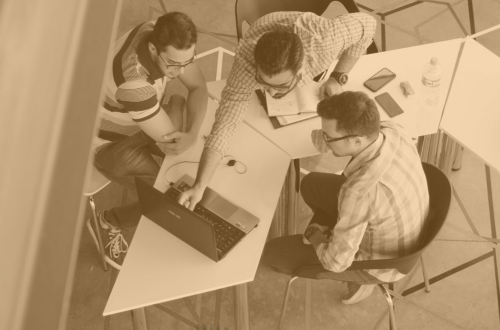Part 2: Infusing Diversity and Inclusion into Everything We Do
“If you see with your heart, all masks disappear.” Sufi saying
Most training and educational sessions that address topics related to interpersonal skills, team dynamics, and leadership can readily apply the 2nd layer for infusing diversity and inclusion. There are two key elements in this layer:
- Use examples and images that shift the traditional ways of depicting people based on their Insider and Outsider group memberships. (Note: The particular terms ~ Insider/Outsider ~ may be more understandable to most participants. I also use the terms “dominant and subordinated groups,” “one-up/one-down groups” and “marginalized” or “under-represented groups” depending on the context of the session. I believe any of these terms can be used to teach about the inherent structural differences among social identity groups in current society with respect to power, access to resources and status, and differential treatment.) ~ and,
- Design activities to minimize any negative differential impact on members of different social identity groups by race, nationality, gender identity, sexual orientation, level, age, ability/disability, etc.
1. Intentionally including stories and images that subtly challenge common stereotypes and the status quo of the organization provides participants with the opportunity to question their current attitudes, beliefs, and behaviors. For example, during a class on coaching skills the facilitator can use an example of a white heterosexual male seeking support about anxiety and test-taking from an adviser who is a Latina lesbian. Or in a session on developing effective teams the trainer can use a PowerPoint image that shows a team that is diverse by a variety of differences being facilitated by co-leaders who are different by race and (perceived) gender identity. It is important to depict realistic images that depict situations that stretch the participants’ unconscious beliefs about which groups are usually good leaders, smarter, more competent, etc.
It is also critical that all participants can “see themselves” in the stories and case studies you use. A common trap is to only use images of members of marginalized/outsider groups in leadership and positive roles while having the unproductive roles depicted as members of insider/dominant groups. Balancing the images across insider/outsider groups is critical in graphics, activities, text, videos, etc. For instance, if you have 8 scenarios or stories during a session, make sure that several depict positive images of members of dominant groups as allies and effective leaders, as well as a couple situations that have members of outsider groups in roles where they are the learner or in need of some coaching and support.
2. The second aspect of this layer to infuse diversity and inclusion is to intentionally design activities to minimize any negative differential impact on members of different identity groups by race, nationality, gender identity, sexual orientation, level, age, ability/disability, etc. When I was first facilitating sessions on diversity I was using activities that I liked and could easily facilitate…I was not conscious that some of these activities might have had a negative impact on participants depending on their group memberships. I then began to realize that many of the experiential activities were not accessible to people with some types of disabilities, including: the “Step-In” activity required people to walk into and stand in the center of the circle as well as visually observe who was in the circle and who was not, and even its name implied a certain level of privileged ability; reflective writing activities required that participants have a certain level of cognitive and physical capacity, much less a level of English proficiency. I often use an activity that invites people to first write an anonymous example of an exclusionary situation, and then read and listen to these stories in small groups ~ participants who are visually and/or hearing impaired will not have easy access, and participants with some types of learning disabilities/dyslexia may feel very uncomfortable much less unable to complete this activity. In this situation I now state the following in hopes to make this activity more universally accessible: When I ask people to write an example, I intend to also say, “If you don’t have an example you want to write about, feel free to share it verbally once you get into small groups.” And when I invite them to start reading the examples aloud in their small group I state, “And if at this moment you don’t feel like reading aloud, just pass your examples to someone else. Some people may be too tired or prefer to learn by listening right now…” One final way I am trying to use the principles of Universal Design more as I train is to use multiple senses at once. For instance, I always repeat anything I use that is in writing ~ when I use PowerPoint slides, I read aloud whatever is on the slide. And if I give verbal directions, I also have them listed on a chart pad or a slide. I usually ask about the varying accessibility of needs of participants before I design a session, and so can send the handouts and Power Points ahead to participants to upload onto their various readers, as needed.
I began to realize how many of my activities and worksheets were inaccessible in other ways when I was asked by a campus to develop trainings for the staff of the Dining and Maintenance areas. These particular participants reflected some demographic groups than I was not as used to training: most of them had not attended college, many had not completed high school, a significant minority had moved to the U.S. from countries where English was not a common language, and many had a relatively low proficiency in English writing literacy. If I had not revised my design and handouts, many of the participants would have felt negatively impacted during the session. Some ways I tried to increase the accessibility of what I was teaching, included: broadening my examples to include dynamics of nationality, and citizenship, as well as hierarchical level and social class; minimizing the amount of reading and writing that I used in activities; partnering with a translator during the sessions with employees who were Laotian and Chinese and did not speak English; shifting my terms to eliminate jargon (so much more easily said than done!); creating more opportunities for participants to share their experiences and examples, and then used these as teachable moments to explore the concepts and tools of the session; increasing the use of experiential activities to teach concepts and abstract models, and then lightly covering the key points in the debrief of the activities; including handouts that covered all of the concepts and tools in the session for those who wanted to review them to reinforce learning.
One final area where I am trying to increase my awareness of how my actions and comments negatively impact across group memberships involves issues of gender identity ~ and this may not be the most accurate term to describe what I am working on…Recently several participants have given me feedback about how I assume the gender identity of participants before they name it for themselves. For example, during a group conversation my intent was to notice that most of the comments had come from people of color and that the whites in the room had not verbally participated. I said something like, “I’m noticing that it is mostly men and women of color who have been sharing examples. I’m curious what some of the whites in the room have experienced on their campuses.” What I didn’t realize is that someone who identified as gender queer had shared a couple of stories. I had made them invisible, replicated trans oppression, by assuming everyone who had shared identified as either man or woman. Another way I gender participants is when I use she or he pronouns to refer to people before they have named their preferred pronoun…or how I unconsciously use “Sir” and “Mam” as I call on or thank participants. I am realizing how engrained these behaviors and assumptions are in me…and I intend to keep myself more conscious and work to not gender people until they have named it for themselves.
My intent of sharing all these examples of how I am trying to make my sessions more accessible is several-fold: 1) I hope you recognize I am very much on a learning curve as I try to remain conscious and shift my approaches to meet the learning needs of ALL people in the room; and my hope is that you have additional examples of how you shift more traditional diversity/inclusion activities to minimize the negative differential impact of participants based on their multiple group memberships. I look forward to learning from your comments!
Continue reading below for my 1st post ~ the 1st layer of this cake!
In my next blog I will explore the 3rd layer of this cake ~ ways to infuse diversity and inclusion into all of our training and educational sessions.



3 Comments
Paulette Dalpes
Thoroughly enjoyed reading both entries! Hands on, applicable, concrete, relevant, insightful words of wisdom and experience which I hope to apply to my work. Thank you!
Dafina Lazarus Stewart
Kathy, this is a really excellent piece. Thank you for sharing! Especially regarding the gender identity piece, this is so ingrained that even as someone who identifies as gender queer, it is easy to fall into the socialized norms of sir/madam, he/she, men/women, etc. You’ve given me lots of good fodder to keep in mind as I design my classes – regardless of topic, but especially when teaching about issues of privilege and oppression.
Kathy Obear, Ed.D.
I’m delighted you found this helpful, given all you do!! And I’m hoping most faculty and staff might also gather a few ideas from these posts, regardless of the content of their courses and workshops!